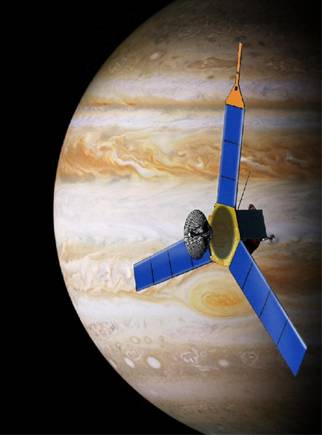25 November 2008

Credit: NASA/JPL
NASA is officially has begun a mission to conduct an unprecedented, in-depth study of Jupiter, the largest planet.
The mission, known as Juno, will be the first in which a spacecraft is placed in a highly elliptical polar orbit around the giant planet to understand its formation, evolution and structure. Beneath its dense cloud cover, Jupiter preserves secrets to the fundamental processes and conditions that prevailed in the young Solar System.
"Jupiter is the archetype of giant planets in our Solar System and formed very early, capturing most of the material left after the Sun formed," said Scott Bolton, Principal Investigator of the Juno mission. "Unlike Earth, Jupiter's giant mass allowed it to hold onto its original composition, providing us with a way of tracing our Solar System's history."
The spacecraft is scheduled to launch aboard an Atlas rocket from Cape Canaveral, Florida, in August 2011, arriving at Jupiter in 2016. The spacecraft will orbit Jupiter 32 times, surveying about 4,800 km over the planet's cloud tops for approximately one year. The mission will be the first solar powered spacecraft to operate at large distances from the Sun.
Jupiter is approximately 700 million km from the Sun, or five times the average Earth-Sun distance. "Juno is engineered to be extremely energy efficient," added Bolton.
The spacecraft features a camera and nine science instruments to study the veiled world below Jupiter's colorful clouds. The set of science instruments will investigate the existence of an ice-rock core, Jupiter's intense magnetic field, water and ammonia clouds in the deep atmosphere, and explore the planet's southern auroras.
"In Greek and Roman mythology, Jupiter's wife Juno peered through Jupiter's veil of clouds to watch over her husband's mischief," said Professor Toby Owen, co-investigator at the University of Hawaii in Honolulu. "Our Juno looks through Jupiter's clouds to see what the planet is up to, not seeking signs of misbehavior, but searching for whispers of water, the ultimate essence of life."
Understanding the formation of Jupiter is essential to understanding the evolution of the Solar System and the early Earth. Jupiter’s composition is similar to that of the Sun, consisting mostly of hydrogen and helium. The elements heavier than helium represent only a small percentage of the planet’s chemical makeup. However, the abundance of these elements in Jupiter is larger than that of the Sun.
“Juno's extraordinarily accurate determination of the gravity and magnetic fields of Jupiter will enable us to understand what is going on deep down in the planet," said Professor Dave Stevenson, of the California Institute of Technology. "These and other measurements will inform us about how Jupiter's constituents are distributed, how Jupiter formed and how it evolved, which is a central part of our growing understanding of the nature of our Solar System."
Deep in Jupiter's atmosphere, under crushing pressure, hydrogen gas is squeezed into a fluid known as metallic hydrogen. At these great depths, the hydrogen acts like an electrically conducting metal which is believed to be the source of the planet's strong magnetic field. Jupiter is also believed to have a solid rocky core at its center.
"Juno gives us a fantastic opportunity to get a picture of the structure of Jupiter in a way never before possible," said James Green, Director of NASA's Planetary Division at NASA Headquarters. "It will allow us to take a giant step forward in our understanding on how giant planets form and the role that plays in putting the rest of the Solar System together."
Juno is the second spacecraft of NASA's New Frontiers Program. The first was the Pluto-bound New Horizons spacecraft, launched in January 2006, and scheduled to reach the Pluto system in 2015. The program provides opportunities to carry out several medium-class missions defined as top priorities in the Decadal Solar System Exploration Survey, conducted by the Space Studies Board of the National Research Council.
Further Reading
NASA
www.nasa.gov/
Juno
http://juno.nasa.gov
Aymen Mohamed Ibrahem
Senior Astronomy Specialist